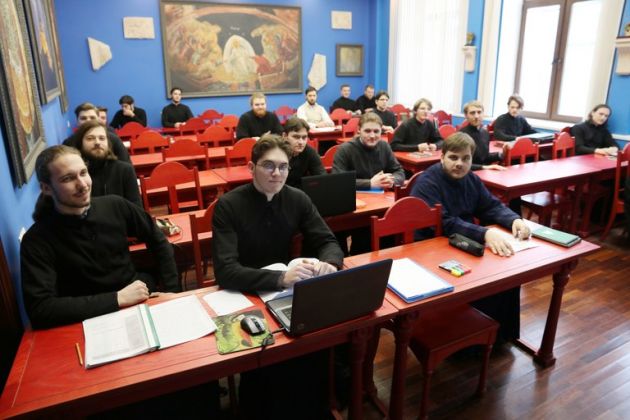Historical Moscow monastery that was place of torture in Soviet era now thriving theological school

The 600-year-old Sretensky monastery in Moscow's center was not so long ago a place of imprisonment and execution of those persecuted for their political or religious beliefs during repressive Soviet times.
Now the historic site is a modern Orthodox Theological seminary founded in the mid-1990s dedicated to New Martyrs and Confessors of the Russian Orthodox Church.
The site was visited by the World Council of Churches general secretary Rev. Olav Fykse Tveit during his visit to Moscow in January 2019 for the 10th Anniversary of Patriarch Kirill's enthronement in the Russian Orthodox Church.
The name of the monastery derives from the Russian "sretenie," points to a meeting that occurred in the same area centuries ago.
Historical references point to one of the most famous Orthodox icons - Our Lady of Vladimir, a medieval Byzantine icon thought to have been painted originally in Constantinople.
It was moved from the city of Vladimir to Moscow 200 kilometers away in August 1395 and miraculously saved the capital from the imminent invasion of emperor Tamerlane's army.
In the place where Moscow's inhabitants greeted the icon, a wooden church was built, and a men's monastery – carrying the name "Sretensky" - was founded.
SOVIET ERA CLOSURE
Although the Sretensky monastery became one of the main Orthodoxy centers in Moscow by the 20th century, in 1925 during the Soviet era, the monastery was closed and most of its buildings destroyed.
The site was turned into imprisonment camp, were people persecuted by Soviet regime were tortured, executed and buried.
The Church of the Meeting of the Icon of Our Lady of Vladimir was the only building not dismantled.
Its unique frescoes from 1707 survived thanks to the layers of paint and wallpaper covering them during Soviet times when the building was a dormitory.

The Sretensky Theological Seminary, one of the leading Orthodox higher education institutions in Moscow, was founded in the monastery's territory in 1999.
The former school building transformed into a modern state-of-the-art training center for the future clergy of the Russian Orthodox church
Tradition meets the high-tech in the seminary's lobby, where the panoramic fresco "Christ and his disciples" is accompanied with a touchscreen device enabling viewers to click on a particular figure to learn more.
Among the disciples, saints, and martyrs, one can spot several Russian Orthodox authorities as well as famous Russian writers like Fyodor Dostoyevsky or Ukrainian-born Nikolay Gogol.
"They were disciples too," says the seminary guide.
ACCREDITED COURSES
Currently, there are around 200 students in the seminary, which offers accredited bachelor's and master's degrees in theology.
Besides studying in the well-equipped classrooms and taking an active part in the monastic prayer life, students are encouraged to stay in an excellent physical shape in the seminary's sports hall.
The silhouette of the newly built monastery church stands out in this part of the city, Lubyanka the area that once headquartered the KGB, Soviet secret service, was completed in 2017, and dedicated to the recent martyrs of the Russian Church persecuted right there.
The cathedral's building symbolizes the victory of Christ's resurrection over death and evil with its full name, "Church of the Resurrection of Christ and the New Martyrs and Confessors of the Russian Orthodox Church."
Patriarch Kirill led the first divine liturgy and the consecration of the church in May 2017 that President Vladimir Putin attended.
"The place where the monastery is built, is a former place of imprisonment, suffering and the martyrdom of many confessors – hierarchs, priests, lay people," recalled Metropolitan Tikhon (Shevkunov), superior of the Sretensky monastery who supervised the construction process of the new church.
"To build a church dedicated to their faithfulness, courage and spiritual riches, asking for their prayers, was our ultimate calling," recalls Metropolitan Tikhon (Shevkunov), superior of the Sretensky monastery who supervised the construction process of the new church."
As a result of competition between new Russian architects, the design and interior of the newly built church open a more contemporary page in the Orthodox architecture in Russia.
Thanks to the digitally controlled internal climate system, it does not matter at all that it has been freezing in the streets of Moscow.
This is an edited piece by Ivars Kupics that was written orginally for the World Countil of Churches
